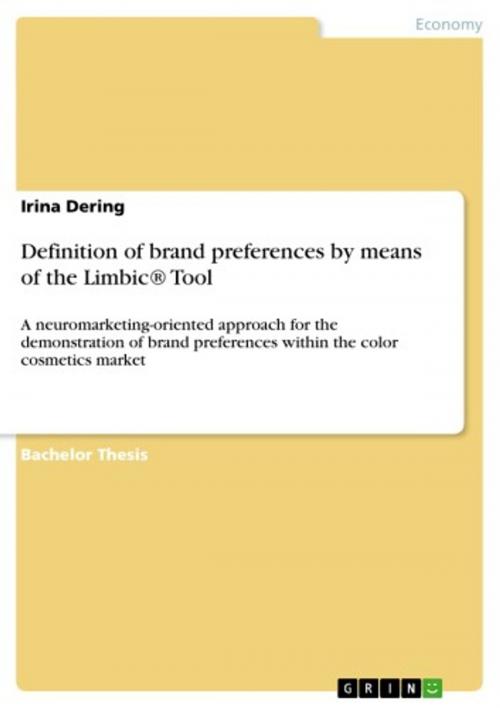Definition of brand preferences by means of the Limbic® Tool
A neuromarketing-oriented approach for the demonstration of brand preferences within the color cosmetics market
Business & Finance, Marketing & Sales| Author: | Irina Dering | ISBN: | 9783640725267 |
| Publisher: | GRIN Publishing | Publication: | October 18, 2010 |
| Imprint: | GRIN Publishing | Language: | English |
| Author: | Irina Dering |
| ISBN: | 9783640725267 |
| Publisher: | GRIN Publishing |
| Publication: | October 18, 2010 |
| Imprint: | GRIN Publishing |
| Language: | English |
Bachelor Thesis from the year 2010 in the subject Business economics - Marketing, Corporate Communication, CRM, Market Research, Social Media, grade: 1.7, University of Applied Sciences Saarbrücken, language: English, abstract: Neuromarketing is the current discipline that generates new hope and excitement at the enterprises for understanding how the consumer works and how to make him buy their products. The meanwhile popular term 'Buy button' is supposed to be located in the human brain and enable to make people buy when 'engaging' it. Apart from this probably utopian intention it is certain that findings of the neuroscience has been very helpful for the marketing-oriented research work and thus for the marketing practice. In the huge range of products brand preferences are getting more and more important for producers as well as for consumers. For decades market research institutions, and companies try to give an answer to the question how brand preferences arise and whether they can be influenced. But the classical market research methods provide an increasingly distorted image of the results as meanwhile consumers understand the goals of the survey and therefore give matching instead of honest and spontaneous answers to the questions of the interviewer. In contrast to that the neuromarketing applies instruments of the brain research and can thus see what is going on in the brains of the respondents while being interviewed.This paper deals with the application of current findings of neuromarketing to the emotionalization of brands. As an example for this intention the author has chosen the color cosmetics market as such purchases are highly emotional. Not even the economy crisis was able to change the fact that the total sales of the cosmetics and toiletries market has been rising over the past years. Women still enjoy buying color cosmetics in order to embellish the everyday life by indulging themselves and keeping up their appearance for the sense of well-being. Hence many people talk about the so-called 'Lipstick Effect' which has been arisen from a strange theory of Leonard Lauder, head of the cosmetic group Estee Lauder. He claimed that there is a coherence between the sales of color cosmetic articles (especially the lipstick) and a cyclical downturn which will be proven by the current figures of the cosmetic market.
Bachelor Thesis from the year 2010 in the subject Business economics - Marketing, Corporate Communication, CRM, Market Research, Social Media, grade: 1.7, University of Applied Sciences Saarbrücken, language: English, abstract: Neuromarketing is the current discipline that generates new hope and excitement at the enterprises for understanding how the consumer works and how to make him buy their products. The meanwhile popular term 'Buy button' is supposed to be located in the human brain and enable to make people buy when 'engaging' it. Apart from this probably utopian intention it is certain that findings of the neuroscience has been very helpful for the marketing-oriented research work and thus for the marketing practice. In the huge range of products brand preferences are getting more and more important for producers as well as for consumers. For decades market research institutions, and companies try to give an answer to the question how brand preferences arise and whether they can be influenced. But the classical market research methods provide an increasingly distorted image of the results as meanwhile consumers understand the goals of the survey and therefore give matching instead of honest and spontaneous answers to the questions of the interviewer. In contrast to that the neuromarketing applies instruments of the brain research and can thus see what is going on in the brains of the respondents while being interviewed.This paper deals with the application of current findings of neuromarketing to the emotionalization of brands. As an example for this intention the author has chosen the color cosmetics market as such purchases are highly emotional. Not even the economy crisis was able to change the fact that the total sales of the cosmetics and toiletries market has been rising over the past years. Women still enjoy buying color cosmetics in order to embellish the everyday life by indulging themselves and keeping up their appearance for the sense of well-being. Hence many people talk about the so-called 'Lipstick Effect' which has been arisen from a strange theory of Leonard Lauder, head of the cosmetic group Estee Lauder. He claimed that there is a coherence between the sales of color cosmetic articles (especially the lipstick) and a cyclical downturn which will be proven by the current figures of the cosmetic market.















